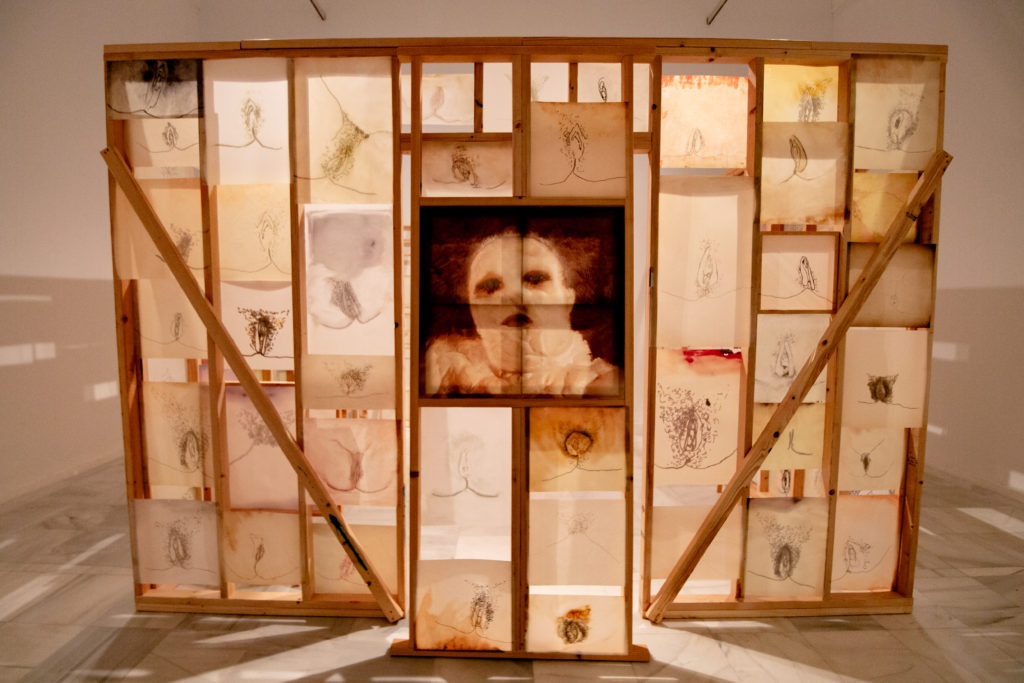Turning museums into feminist spaces

In the Reina Sofia Museum, Madrid, an entire room is dedicated to the feminist drawings of Ida Applebroog – Credit: Javi García Nieto
Traditionally, museums are spaces of cultural expression governed by a masculine standview. But in Spain, some museums and non-profits are taking concrete steps hoping to make women artists’ work more visible and to rethink the cultural world’s influence on gender equality.
By Ana Requena Aguilar, elDiario.es (Spain)
Have you ever noticed how many artworks by male artists and how many by female artists hang on the walls of your city’s main museums and galleries? How are these works described in the information tag next to each piece of art? Which themes are chosen for exhibitions? In Spain, Women in the Visual Arts (MAV) has. For the past 12 years, this collective of artists and art professionals has been working to introduce a gender perspective into the art world, especially in museums and galleries.
The country’s main museums have an overwhelming majority of art produced by male creators in their collections, while women still represent a significant minority. The same happens with the temporary exhibitions, which predominantly feature male artists. For example, the Prado Museum in Madrid —one of the world’s leading cultural institutions— only organised its first temporary exhibition dedicated to a female painter in October 2016. It featured the works of Clara Peeters, a Flemish painter and pioneer of still life — a stigmatized art genre at the time, precisely because it was associated with female creators.
Beyond looking at the quantitative aspect, rethinking museums involves reviewing many other variables. « From questioning how they operate internally —the majority of museum trustees’ boards are male-dominated and decision making is thus very masculinised—, to the representation of female artists in exhibitions, to encouraging research to rescue much more female creators than those currently featured. And also re-reading the historical contexts in which these artworks have been produced, contextualising them both in the past and in the present for those who now contemplate them, » says MAV’s president, Lola Díaz.
Since its launch, the collective’s observatory has produced more than 20 reports and institutions’ analysis that have served to draw statistics on the cultural gap, hoping to raise awareness in the art industry and open avenues for dialogue. The Spanish Ministry of Culture itself has risen to the challenge and produced the first report on the application of the Equality Law —passed in 2007— in culture.
Mabel Tapia, deputy artistic director of the Reina Sofía Museum, one of Spain’s top art institutions, shares Díaz’s opinion. The museum has been working for several years now to embrace a gender perspective. Tapia believes that the last decade, marked by the upswing of feminism and the questioning that arise from both initiatives such as the MAV and public opinion, has been a turning point. She underlines that change should not only be quantitative, although increasing the number of female artwork is undoubtedly important to put an end to the male-predominance of artistic spaces.
« At the museum, we work on two levels. First, on the gap that exists in collecting male or female artwork or inviting men or women artists or curators, to settle a historical debt of discrimination. But we also try, above all, to deconstruct a hegemonic, Euro and heteropatriarchal cultural logic, and to build other ways of making and understanding the museum », says Tapia. “Museums have historically had an affirmative and heteropatriarchal way of operating and putting forward culture. Feminism comes to break with this to generate more questions than affirmative answers, to come up with hypotheses without the need to arrive immediately to a universal conclusion… It also involves including other social groups that have often been disregarded in artistic narratives. »
Among these groups that the Reina Sofía seeks to include are domestic workers and strawberry pickers —two of the most precarious and predominantly female labour collectives—, with whom the museum has conducted several actions. Other initiatives have been carried out alongside the residents of the Lavapiés area, adjacent to the museum and one of the most multicultural neighbourhoods in Madrid. The institution has also implemented several feminist tours of its permanent collection, both taking a female artists’ standview and exploring topics that are often undervalued or silenced. It also encourages purchasing artworks produced by women.
Tapia emphasises for instance the need to change « the way of telling stories, the narration » of the content, as well as the museums’ layout, to avoid giving the impression that women artists are always « the others, » and that their works are added as complements. The Reina Sofía is currently reorganising its permanent collection with these ideas in mind. In one of its rooms, the ideal American home of the mid-20th century contrasts with Louise Bourgeois’s huge ‘Spider’, which also represents a ‘home,’ a ‘mother,’ that the artist conceived in a very different way. Presented in another room, the culminating works of artist Ida Applebroog, whose work is intertwined with feminism — an installation with drawings she made for months about the daily observations of her vagina.
This is another one of the missions that the Reina Sofía has committed to — making the work of female creators, who have not been considered part of the history of art, visible. One of them is Charlotte Johannesson, at the center of one of the museum’s current temporary exhibitions. The Swedish artist’s work, which combines a loom and an Apple II Plus computer, has hardly been exhibited in major museums.
Mabel Tapia is well aware that the gender gap in her museum is still there, but she describes in detail and with conviction all the efforts the institution has been doing to tackle the issue. Beyond its own individual initiatives, Women in the Visual Arts will soon be launching a self-diagnosis tool, in Spanish and English, to help any museum or gallery analyse « their structure, their internal work and their external activities from an equality perspective », says the non-profit. Lola Díaz, its president, concludes: « We need to move towards museums and cultural centres with a more anthropological, less colonialist outlook, that question the past and the present, re-read and recontextualize their collections. Diverse and inclusive museums that represent society as a whole. »

This article is being published as part of “Towards Equality”, an international and collaborative initiative gathering 15 international news outlets to highlight the challenges and solutions to reach gender equality.




